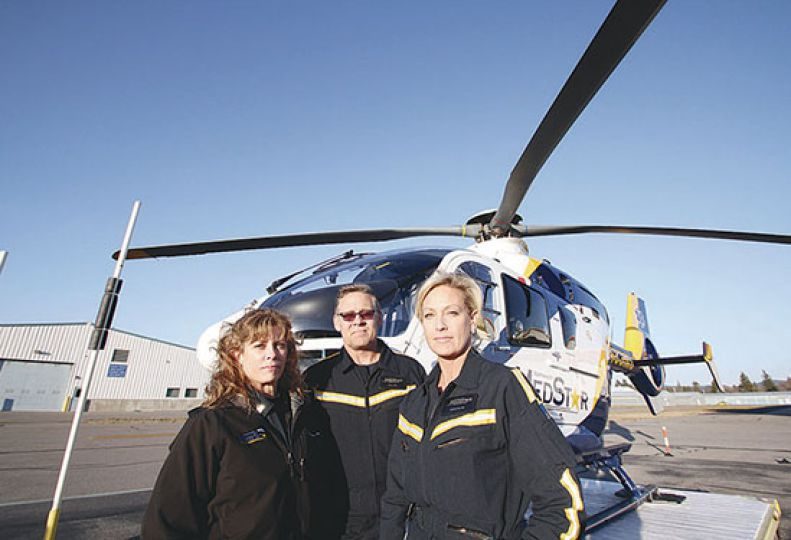
Home » NW MedStar boosts its fleet with $9 million purchase
NW MedStar boosts its fleet with $9 million purchase
Air ambulance provider to operate six helicopters once new aircraft arrives

December 5, 2013
Northwest MedStar, the Spokane-based air ambulance service operated by nonprofit Inland Northwest Health Services, expects to take delivery early next year of the second of two helicopters it has bought this year.
The first twin-engine EC-135 helicopter, which arrived in June, is based mostly in Spokane, says Nicole Stewart, spokeswoman for INHS.
MedStar paid about $9 million combined for the two rotor-wing aircraft, including medical equipment, Stewart says.
The additional aircraft will bring the total number of MedStar EC-135 helicopters to six, with five of those available for service and one serving as a backup, says Eveline Bisson, MedStar program director. MedStar serves Eastern Washington, North Idaho, western Montana, and northeastern Oregon.
"The helicopters are a newer model EC-135, and they're a bit faster, have more lift capability, and an updated avionics suite," Bisson says.
She adds, "We're always looking for better ways to serve the community. We were a little shy to totally meet the needs in certain regions."
In addition to its headquarters and base at Felts Field in East Spokane, MedStar operates three satellite facilities in Eastern Washington: at Richland, Moses Lake, and the Pullman-Moscow Regional Airport.
The sixth helicopter arriving in the first quarter of 2014 will be stationed mostly at one of the satellite bases, but Bisson says MedStar hasn't yet determined which one. Typically, MedStar has two helicopters primarily based in Spokane, and one helicopter at each of the other satellite facilities, she says.
The new helicopters are equipped with several updates, including an awareness system that enables pilots to monitor air traffic in the vicinity during a flight, similar to the radar equipment used in airport control towers, Bisson says.
"The traffic collision awareness system looks like a radar screen in an air traffic control tower, but it's on the console with blips of where other air traffic is located," she says.
She adds that MedStar pilots are accustomed to the safety protocols of landing and taking off from airfields that aren't staffed by air traffic controllers. Under those conditions, pilots follow the prescribed protocols to coordinate activity with other pilots over a shared radio frequency.
"We mostly go into uncontrolled airfields, so we're used to that," Bisson says. "To have additional awareness of traffic in the area, it's a nice safety enhancement."
The new EC-135s also have updated terrain-awareness equipment that provides additional visual and auditory information to a pilot about surrounding terrain and elevations, including topographic mapping such as for an upcoming mountainous region. MedStar's other helicopters have that option as well, but Bisson says the system on the new aircraft is more enhanced.
She says the internal cabins are similar in size and layout to current MedStar helicopters, although the new ones have some modifications in how medical equipment is set up. The helicopter can fit up to six people total, including two patients, medical crew members, and a pilot.
MedStar transports an average of about 3,500 patients a year, and Bisson says the service expects the number of transported patients to be closer to 3,600 this year.
MedStar has just over 100 full-time-equivalent employees, who mainly include medical crew members such as nurses and respiratory therapists. However, its overall workforce includes about 150 people because it contracts for its pilots and mechanics with Metro Aviation Inc., of Shreveport, La., Stewart says.
The average age of the helicopters in MedStar's fleet are about 10 years, Bisson says, but she asserts that age still is relatively young compared with aircraft operated by other service providers in the air ambulance field.
She adds, "An older aircraft is like an older car. They're safe to operate and well maintained, but as they age they require more maintenance. That means more down time, so one might not be available. We try to stay ahead of that. We're being proactive."
In 2009, INHS bought the formerly leased 22,800-square-foot hangar at Felts Field that houses MedStar's main operations. During that same year, MedStar also acquired three new fixed-wing airplanes for longer-distance medical transports. Two of those aircraft are in Spokane, and the third is in the Tri-Cities.
MedStar's fleet also includes seven ground ambulances, which it uses to transport patients to medical facilities when providing fixed-wing flights, or when inclement weather such as a snowstorm prevents use of the helicopters.
The EC-135 helicopters are manufactured by France-based Eurocopter Group, but Metro Aviation modifies the aircraft for MedStar's medical transport use.
"The back is modified for the air-ambulance area," Bisson says. "The EC-135 we have is the most popular in the industry because of the cabin size and the self-contained stretcher."
Stewart says MedStar doesn't plan to purchase additional aircraft or other major equipment this year, although it's always evaluating future needs.
Latest News Special Report Health Care
Related Articles
Related Products

![Brad head shot[1] web](https://www.spokanejournal.com/ext/resources/2025/03/10/thumb/Brad-Head-Shot[1]_web.jpg?1741642753)

